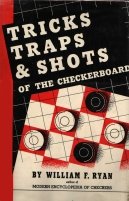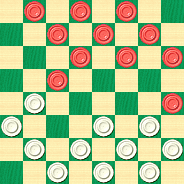The Checker Maven
Jump to navigationNow You Dunne It

We think the poor fellow in the cartoon above is going to be in a lot of trouble in very short order. We only hope that he can somehow win the situation, but that's going to be quite a challenge.
Another kind of win that's a real challenge occurs in our game of checkers (although we'll bet it's easier than the situation depicted in the cartoon). It's known as Dunne's Win and it will be explained to us by Willie Ryan, as we quote from his classic Tricks Traps & Shots of the Checkerboard.

"Similar to the difficult George Dick Gambit, the ever practical Dunne's Win is a delicately balanced positional win that white is required to engineer by precise play.
Here's the run-up: 9-14, 22-17, 11-16, 25-22, 8-11, 22-18, 16-20, 18-9, 5-14, 29-25, 4-8---A, and we have the position depicted on the diagram, known as 'Dunne's Win.'

WHITE
White to Play and Win
W:W32,31,30,28,27,26,25,24,23,21,17:B20,14,12,11,10,8,7,6,3,2,1.
A---Black's position is hopeless after this move, with 22 pieces still on the board. The correct procedure is 11-15*, 25-22, 7-11*; now either 17-13 or 24-19 taxes black. For continuation, see Reisman's Pioneer Book, the leading authority on this formation."
Can you do this problem, or will you get Dunne on? When you Dunne done it, click on Read More to see the solution and notes.![]()
Solution

WHITE
White to Play and Win
W:W32,31,30,28,27,26,25,24,23,21,17:B20,14,12,11,10,8,7,6,3,2,1.
"Continue:
| 25-22 | 22-17 | 13-6 | |
| 11-16 | 15-24 | 3-7 | |
| 24-19 | 23-19 | 6-2 | |
| 8-11 | 16-23 | 7-11 | |
| 22-18 | 27-9 | 2-7 | |
| 1-5 | 10-15---F | 10-15 | |
| 18-9 | 25-22 | 7-16 | |
| 5-14---B,1 | 24-28 | 15-22 | |
| 26-22 | 9-5 | 16-19 | |
| 11-15 | 6-10 | 23-26 | |
| 30-25 | S-1 | 19-23 | |
| 15-24 | 15-19---2 | 26-30 | |
| 28-19 | 22-18 | 17-14 | |
| 7-11---E | 19-23 | White win---3 | |
| 17-13 | 1-6 | Frank Dunne. | |
| 11-15 | 2-9 |
B---All roads lead to defeat. If 6-22 is played, white wins out: 26-17, 11-15---C, 30-25, 15-24, 28-19, 10-14---D, 17-10, 7-14, 25-22, 3-7, 27-24, 20-27, 31-24, 16-20, 22-17, 20-27, 17-3, 27-31, 23-18, 31-26, 18-15, 26-23, 21-17, 23-16, 15-11, 16-7, 3-10, 5-9, 17-13, 12-16, 13-6, 2-9, 32-27. Frank Dunne.
C--- Or 10-14, 17-10, 7-14, 31-26, 3-7, 28-24, 7-10, 26-22, 11-15, 22-17, 15-18 (if black plays 2-7, white wins with 30-25), 30-25, 5-9, 17-13, 2-6, 32-28, and white wins. Frank Dunne.
D---7-11, 17-14, 10-17, 21-14, 2-6, 25-22, 6-10, 14-7, 3-10, 22-17, 5-9, 17-14, 10-17, 19-15, 11-18, 23-5, 17-22, 32-28, 22-25, 5-1, 25-30, 1-6, 30-25, 6-10, and white wins. Frank Dunne and McFarlane.
E---3-8, 19-15, 10-26, 17-1, 26-30, 1-5, 8-11, 5-9, 7-10, 9-5, etc., and white wins. John Hynd.
F---3-7, 25-22, 10-15, 9-5, 15-19, 5-1, 6-10, 1-6, 2-9, 13-6, 19-23, 6-2, 7-11, 2-6, 10-15, 6-10, 15-19, 22-18, and white wins. F. Tescheleit."
1---The computer rates the jump options as just about equally bad and now sees the game as a probable Black loss---Ed.
2---2-7 is rated substantially better by the computer, but the game is lost anyhow---Ed.
3---One way is 22-25 31-26 25-29 23-27 30x23 27x18 29-25 14-10 12-16 10-7 16-19 7-3 19-24 3-7 25-29 18-22 and Black is out of safe moves---Ed.
You can email the Webmaster with comments on this article.
